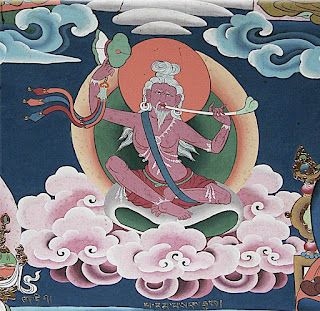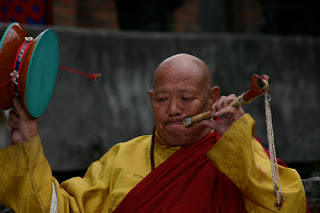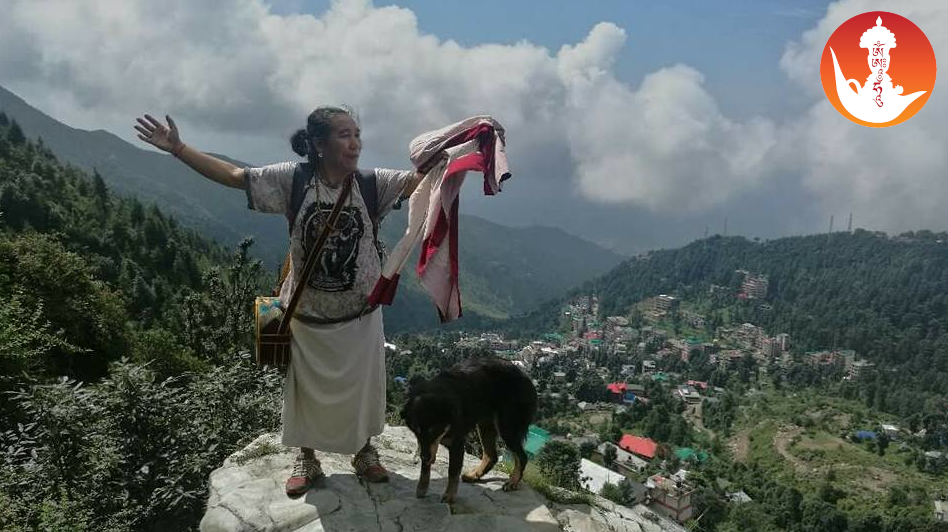How the practice of dharma came from Tibet to rest of the world.
The Chod Meditation tradition comes from an early Tibetan Yogi named Padampa Sangye and from the Tibetan Yogini, Machig Labdron. It is a system practiced by every major school of Tibetan Buddhism, but it is also a complete system of its own. There have been Chodpa’s, practitioners of the Chod Meditation and lifestyle, in Tibetan Buddhism, for over nine hundred years. Chod combines all the elements of Tibetan Buddhism in a pithy, direct style. The practice focuses on the transformation of one’s mind in order to awaken primordial wisdom. It is a dynamic form of meditation which involves visualization, mantra, musical instruments made from bones, meditation, Buddhist philosophy, sacred dance, funeral practice, healing practice and more. Chodpa Kunzang Dorjee continues the Chod tradition, wandering from cremation ground to cremation ground to sing the ancient melodies and express the radical bravery of the Chod lifestyle.
Main Longchen Nyingthik Lineage:
Sri Shinga was the reincarnation of Chenrezig, and Guru Rinpoche who was the speech reincarnation of Amibabha, was a student of Sri Shinga. Guru Rinpoche got a direct transmission from Vajravarahi and Shri Singa.
In Tibet we have two main Dzogchen owners. One was Vimalamitra and his lineage called Vima Nyingthik.
The other, Guru Rinpoche called Dzogpa chenmo Longchen Nyingthik. The Khandro Nyingthik was the treasure of Guru Rinpoche. Khandro Nyingthik was the treasure of Guro rinpoche and was revealed by the terton (treasure-revealer) Dujom Lingpa. It was a very large volume. There are many terton (treasure-revealers) and they all have their own lineage stars in the sky.
Masters in the lineage to which we pray:
Sri Shinga (called Glorious Lion) who was the Rigdzin knowledge holder of the Vidyādhara and the chief of all scholars.
Padmasambhava (Guru Rinpoche): Lotus Born) was a Tibetan Teacher is a famous Indian Buddhist who introduced Tantric Buddhism to Tibet and who is credited with establishing the first Buddhist monastery there.
Yeshe Tsogyal (Queen among dakinis). Born in Tibet Yeshe Tsogyal is the female emanation of Samantabhadra to whom we make requests and pay homage to. She is also the emanation of Vajravarahi (Dorje Phagmo), venerable Tara, and of the secret Krudhakali (Tröma Nagmo), the wrathful black dakini. She is considered the embodiment of all dakinis.
Pema Ledrel Tsal, a disciple who became the lineage holder of Yeshe Tsogyal’s teachings.
Longchen Rabjampa (Longchenpa), a monk disciple who emerged to carry on the lineage from Pema Legdre.
Jigme Lingpa, an emanation of King Trisong Detsen. He was a tantric practitioner, who carried on the lineage from Longchen Rabjampa.
Chögyal Ngakgi Wangpo, Dharmaraja Lord of Speech, from Mongolia who was an emanation of Padmasambhava. He was the next master in lineage.
Shabkar Tsokdruk Rangdrol was the disciple of Chogyal Ngakgi Wangpo was probably an emanation of Milarepa. He constructed many great stupas in Tibet, one of the most important being the Great Stupa in Kathmandu.

Chodpa Kunzang Dorjee’s root teachers are Lama Wangdu Rinpoche and Lama Chodak Rinpoche, who both authorized him as a Chod teacher.

Lama Wangdu Rinpoche is a Tibetan yogi, well-known teacher and healer. He is a lineage holder of the Chod, Zhije, Phowa and Longchen Nyingthig traditions. He was born in Tingri, the hometown of Kunzang Dorjee, where the great founding father of Chod, Phadampa Sangye taught. Under the direction of his teacher, Lama Naptra Rinpoche, he completed the traditional 108 charnel ground practice of Chod in Tibet just before 1959 when the borders were closed. Lama Wangdu Rinpoche was recognized by His Holiness the Dalai Lama as a lineage holder of Chod and Zhije and His Holiness asked Lama Wangdu Rinpoche to spread and preserve these traditions. It was then that Lama Wangdu Rinpoche founded his monastery in Nepal for that purpose. Chodpa Kunzang Dorjee met and trained with Lama Wangdu Rinpoche many years ago. This was before Lama Wangdu Rinpoche had become the famous Chodpa he is today.
Lama Choedak Rinpoche is a Ngakpa or Tibetan Yogi, who lives in full-time retreat near Nagarkot in the mountains above Kathmandu. He was born in Eastern Tibet, in Kham, in the area known as Khams ‘denma. The place he first trained at was called Burleg Monastery (Tib. ‘bur legs dgonpa). The main teacher of that monastery was his first Lama, who was named Gangsar Khenpo Lama. His second Lama was Yagton Sangye Tulku (Tib. gYag sTon Sangs rgyas sprul ku). After he left Tibet he went to India to do his Buddhist philosophy study, studying many classical texts. After this, he went to Pharping, where he did retreat for twenty-one years. Following this retreat, he moved to Naga Kor where he has been for four and a half years living in retreat and practicing. Lama Choedak Rinpoche gave Kunzang Dorjee authorization to teach Chod, perform Mo divination’s, train students and do healing. He instructed Kunzang Dorjee to benefit others through teaching activities and gave his blessing and support for the founding of Khandro Labdron Shije Chod Institute.
One of Chodpa Kunzang Dorjee’s teachers was also Momo-la, a ninety-year-old Tibetan Dakini who lived in full time retreat in Nagakort until her passing in 2019. Her official name was Ani Dawa although she was called Momo-la by her students. Embodying the wisdom tradition of Tibetan Yoginis, she guided Kunzang Dorjee through her own direct experience.
Today Kunzang Dorjee continues the lineage through various activities. He spends time alternating between retreat practice in the cremation grounds of India-Nepal and his work at his center in Boudha, Kathmandu, Nepal, where he trains students in Chod. A rare aspect of his teaching is that he trains students from the beginning in every aspect of Chod practice, including how to use the drum, how to choose instruments, how to chant and visualize. He prepares and trains students for how to do their own Chod retreat including all the classical elements of Chod, the dances, the rituals and most importantly – the way of being.

